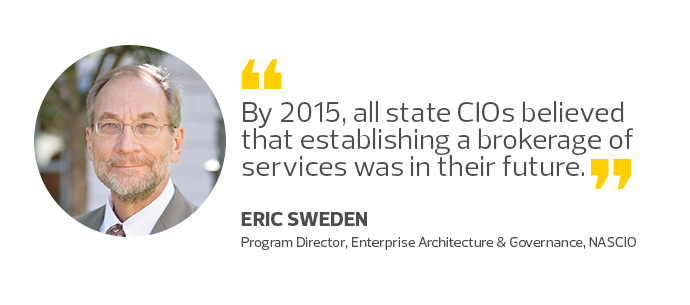State CIOs Build on Mature Consolidation to Shift into Brokerage
Over the past dozen years or so, the experiences of state CIOs have prompted them to embrace a new role, shifting from the concept of an encompassing provider of services to a broker of solutions integrating multiple offerings, platforms, suppliers and the CIO organization.
The National Association of State Chief Information Officers watched that trend develop over those years. By the end of this year, NASCIO will offer guidance for states to move toward this emerging model.
In 2005, our organization researched progress toward consolidation and shared services and learned that more than 60 percent of states had made “good” or “very good” progress in their consolidation efforts. NASCIO’s “Survey on IT Consolidation and Shared Services in the States: A National Assessment” calls for states to be “even more responsive and more capable in delivering services.”
“That capacity rests critically on the task of reengineering business process and eliminating redundancies wherever possible. State CIOs have seized on the potential for galvanizing the state IT enterprise to produce better results and reduce costs by utilizing consolidation and shared service models for infrastructure optimization and to streamline IT functions,” the survey states. But that was during the best of times.
SIGN UP: Get more news from the StateTech newsletter in your inbox every two weeks!
The New Challenge: Managing Multiple Delivery Channels
State governments felt the pain of financial shortfalls during the recession that started in 2008 and extended into 2011, before revenue and budgets recovered. Budget cuts drove states toward new operating models that required rationalizing their investments in technology. State agencies sought more collaborative arrangements for sharing resources and costs through enterprise consolidation. Forty-one states in 2009 and 39 states in 2010 made budget cuts exceeding $30 billion in both years, inspiring new ways of thinking about IT expenditures.
NASCIO’s 2011 Annual State CIO Survey reveals that more than 90 percent of states consolidated various infrastructure and services. Essentially, state CIOs found that previous approaches to IT investments were unsustainable. States could simply not afford to continue to invest in redundancy, lack of coordinated projects and lack of an enterprisewide investment strategy. The challenges to rationalizing investments surfaced at a national level through NASCIO’s annual survey, revealing issues regarding governance for making investment decisions and metrics for measuring and demonstrating progress.

Subsequent annual surveys demonstrated progress and also a maturing from consolidation to the discipline of the CIO as broker. By 2015, all state CIOs believed that establishing a brokerage of services was in their future. The trend advanced in the results from NASCIO’s 2016 and 2017 annual surveys.
According to the report “State CIO as Broker: A New Model,” published by NASCIO in April: “There will necessarily be a combination of internal and external resources, enterprise-wide and agency specific resources, resources gained through purchase, resources gained through renting, resources gained through partnering. Managing multiple delivery channels within a framework for government change then becomes the challenge for all CIOs.”
NASCIO Takes the First Steps Toward CIO Brokerage
In early 2018, NASCIO proposed to develop a playbook for assisting states in their move toward a new operating model and advancing a new role for the state CIO — “State CIO as Broker.” Since approval, NASCIO has been working on a special project with corporate partner Integris Applied. That project operates under the umbrella of the NASCIO Enterprise Architecture and Governance Program, led by Craig Orgeron, CIO of Mississippi, and Eric Boyette, CIO of North Carolina.
The effort employs a maturity model developed by Integris Applied for determining a state’s current level of maturity and presents guidance on how to move to the next level of maturity. The initiative will produce a survey of all states and territories, which ultimately will help states determine just where they are on the maturity model. Those efforts will culminate in a session Oct. 20–23 at the NASCIO Annual Conference in San Diego and a playbook for guiding a broker initiative.
NASCIO is convinced that this year’s efforts are the first step in formalizing an operating model for multisourcing and the role of the state CIO as a broker. We anticipate the discipline will mature and eventually include guidance on identifying gateway characteristics of agency programs, project and management initiatives, and how those characteristics can be used to identify the best sourcing strategy for technology and business services.









